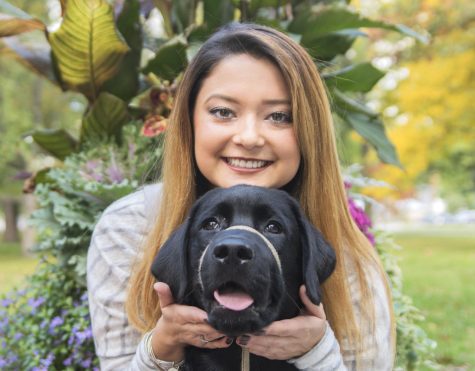Let’s roll: Mastering taste in the sushi chef’s kitchen
March 10, 2015
To start, Chef Andrew Nun palms and shapes a glob of rice equivalent in size to a baseball. It’s been cleaned evenly with rice vinegar — something very important — and cooked at a precise 140 degrees. He stomps the ball of rice out on seaweed paper, sprinkles on sesame seeds and adds cucumber, avocado and mock crab. He rolls it faster than one can say “California.” It must, he said, be fast.
“And it also has to be beautiful,” he said. “And eye catching. This is very, very important.”
Nun, the head sushi chef of Shake, Wrap & Roll, has been making sushi for Kent State students for the past seven years and is still learning the art to this day — something, he said, is never really finished.
From his experience, Nun said there are imperative skills a sushi chef must have: speed, exactness and the ability to blend rice well.
Yet two are mandatory for artistry: an eye and a taste — for beauty.
The art of sushi making dates back to 4th century Japan, when Tokyo fishermen preserved their caught tuna in salt and vinegar, fermenting it in the process (sushi first meant “fermented fish”). They added rice and soy, later wrapping it in nori (seaweed), and the Tokyo, or Edo, tradition was born.
Hundreds of years later in the 1970s, the Japanese brought the then-exotic cuisine to San Francisco, and the Americanization of an old art began to roll.
The sushi “craze” in America produced a smorgasbord of recipes: the balsamic-lathered Dragon Roll; the Surf-and-Turf Roll, often served with barbecue sauce; and even the experimental “Frushi” Roll — which is exactly what it sounds like.
But no creation is as popular as the California Roll, a recipe that Nun said he makes more than any other in his kitchen. For him, it’s a perfect taste-test for sushi virgins: the crunch of the “English” cucumber (Japanese cukes are a lot softer), the creaminess of the avocado and the savory imitation crab. The combination of the common three-pattern ingredient base found in most recipes is what many chefs must be hip to, he said.
Still, he said, that doesn’t mean much.
“Just because you make a lot of recipes doesn’t mean you can make good sushi,” he said.
It’s not much of a secret that the master chefs in Tokyo kitchens have several years of experience. The level of military-like concentration to produce on-the-spot orders at restaurants can mean that most chefs must spend years as “rice washers” before making it to the line.
Yet, American qualifications aren’t as strict.
Coming over to the U.S. from Burma in 2008, Nun found his way to Coconut Creek, Florida with a focused aim to work in sushi. He was an apprentice under his uncle, Tuan Chin, and said it took him “just a month” to gain the tricks needed to work solo in the kitchen. Apart from his Kent State gig, Nun works under contract for Sushi with Gusto, a catering company based in South Carolina.
After seven years, good sushi comes “easily,” he said Perfect sushi is near improbable.
How can he tell?
“From my experience,” Nun said, “I can tell right away, right when I eat the sushi. Even before I eat it.”
Those without a trained palate like Nun’s don’t need such to verify authenticity, quality. As Nun said, one of the most important components in sushi making are “high-quality ingredients,” which often means looking toward the East, primarily Japan, where Bluefin tuna prices can run in the hundred thousands, usually served in Shanghai, China and Seoul, South Korea.
But can American sushi — which often lacks the high-time Tokyo expertise — rekindle the taste of the original thing?
“Not really,” said Shengyu Li, a freshman digital media production major from China. She looks down, contemplating her dish of spicy tuna mixed in Thousand Island dressing, and laughs. “In Japan, the sushi is much simpler — just soy sauce and wasabi for sauce, and that’s it.”
She looks to her friend, junior Haiwen Guo, for further explanation.
“It’s just different,” Guo, an architectural studies major, said, smiling. “It’s hard to explain.”
Nevertheless, both Guo and Li agree that underneath any spicy mayo is, at least, a reputable homage to the real thing, individual preferences aside. Even for Nun, who recalls sushi-tasting in Burma, a Western palate is disparate — with its penchant for sauces and kaleidoscope color — and the result “much different.”
Those with their senses not exposed to the taste of Tokyo only have a singular idea of not just what original sushi tastes like, but also the appropriate, ideal way to eat it. Etiquette goes a long way, Nun said, and exists for a reason.
“To get the best taste with sushi,” Nun said, “you must get all of the sushi inside your mouth all in one” — he picks up a piece of California roll with his thumb and index, showing it off — “It’s the only way.”
By the look on Nun’s face after the bite it’s clear: Beauty is taste, and taste beauty.
Contact Mark Oprea at [email protected].






















